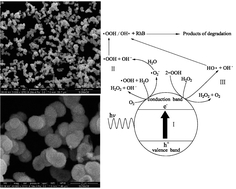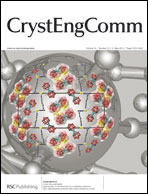Facile synthesis and photocatalytic application of hierarchical mesoporous Bi2MoO6 nanosheet-based microspheres†
Abstract
In this study, mesoporous aurivillius bismuth molybdenum oxide (Bi2MoO6) (A-BMO) microspheres were fabricated via a template-free solvothermal process in the presence of ethylene glycol. The as-prepared Bi2MoO6 products were characterized by X-ray diffraction, scanning electron microscopy, UV–vis diffuse reflectance spectroscopy and nitrogen adsorption–desorption techniques, respectively. Results showed that the synthesized Bi2MoO6 microspheres were composed of nanosheets, with diameters of 0.5–1.0 μm, specific surface areas of about 50.86 m2 g−1, and a band gap energy of about 2.59 eV. The photocatalytic activity of the Bi2MoO6 microspheres was evaluated in the decomposition of rhodamine B (RhB) under xenon lamp irradiation. The A-BMO showed superior performance for the photodegradation of RhB, in comparison to the commercial P25 in the H2O2-containing system. The sedimentation, stability and recycling performance of the prepared A-BMO catalysts were also investigated. This study provided new insights into the design and preparation of functional nanomaterials with sphere structures in high yields, and the as-grown architectures exhibited potential ability to remove organic pollutants in wastewater.


 Please wait while we load your content...
Please wait while we load your content...